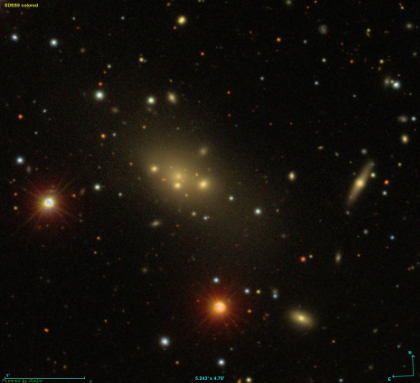October 2016 - Galaxy of the Month
NGC 7046 in Equuleus
This interactive image of the NGC 7046 was provided by the Sloan Digital Sky Survey using Aladin Sky Atlas. We also have a finder chart should help you locate these galaxies.
Equuleus is not a constellation often thought of in deep sky circles, with good reason as there is really nothing of note in the constellation. It does however boast one reasonably bright galaxy in NGC 7046.
First discovered by William Herschel in October 1790, NGC 7046 is a barred spiral galaxy with a listed magnitude of 14. The core of the galaxy is probably all that will be seen, except with the largest scopes, of this object. It does have a fainter halo with some structure.
NGC 7046 is listed as part of a small group of galaxies including IC 1364 and IC 1368. The group is at a distance of perhaps 55 Mpc and appears fairly isolated. There is no evidence of any interactions in the group.
NSOG suggests 30cm is probably needed to see NGC 7046 and to use a relatively high power in which case more detail than just the core may be seen. L&S suggests 25cm will show it but 30cm is needed to see much detail. Although there are a number of IC objects in the general area of NGC 7046 most were found with a 30” reflector, however two, IC 1365 and IC 1368, were found by the 16-year-old Edward Swift using the 16” refractor that his father Lewis also used. As such these should be visible in larger modern telescopes (say 40cm+) from a good sky.
IC 1365 is interesting because it is also included in the VV catalogue of interacting galaxies as VV 508. In NED IC 1365 is given as a designation not to one object but to a group of galaxies closely packed together, it was probably the fact that they are so close that it was thought to be an interacting galaxy.

The central galaxy in the group has a classification of cD i.e. a giant amorphous elliptical of a type normally found at the centre of clusters. It appears to have several other galaxies superimposed on its halo. It will be interesting to see if any of the large telescope owners can separate the galaxies. The group appears to be at a distance of about 207 Mpc.
The other Swift discovery, IC 1368, is actually over the border in Aquarius and quite a distance (40.8’) from NGC 7046. It appears to be quiet a nice edge on spiral galaxy. There are no visual observations I can find for IC 1365 or IC 1368.
Owen Brazell - Galaxy Section Director